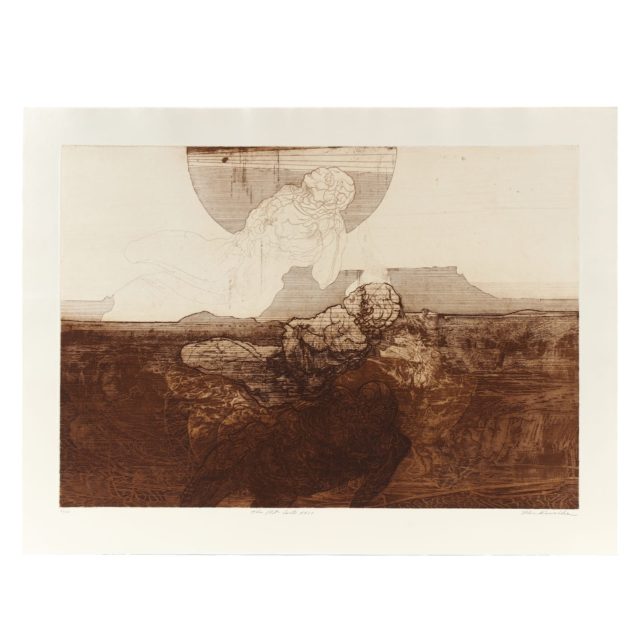Ron Kowalke (American, b. 1936)
Inferno, 1970
Gift of Sanford R. Robertson
Born in 1936, Ron Kowalke is an American painter, printmaker, sculptor, and educator. After attending the Art Institute of Chicago and the University of Chicago, he received his BA from Rockford University in 1959. By 1960, he went on to receive an MFA from Cranbrook Academy of Art. Kowalke taught alongside his practice at Northern Illinois University, Swain School of Design before joining the faculty of University of Hawaii. His work is part of prestigious permanent collections across the continent, including the Metropolitan Museum of Art, the Boston Public Library, the Library of Congress, and the Honolulu Academy of Art.
With this portfolio comprised of ten prints, Kowalke elaborates on Henry Francis Clay’s translation of Dante’s “Inferno” one Canto at a time. He takes on the role of Virgil, interpreting for us an unfamiliar afterlife.
“That thou mayst follow me, and I thy guide
[1]
Will lead thee hence through an eternal space,
Where thou shalt hear despairing shrieks, and see
Spirits of old tormented, who invoke
A second death. . . ”
Kowalke echoes the extreme linear perspective of the High Renaissance, using horizontal lines to force the main figures into the foreground. With nowhere to rest between these impenetrable layers of the inferno, my eyes settle on an obscured human form, void of identity and personhood. When my eyes venture past the figure and into the shadows, I find delicate patterns that indicate movement, giving context to the whole of the figure. Each piece is rich with gestures. The static splotches of ink and rippling distortion of the body work together to illustrate a supernatural force of decay.
In the featured piece, The Pit, an apparition stretches away from a darker figure in the same pose, dissolving into the background. The darkest figure plunges into the ground, cringing with exposed internal anatomy. Three stages of movement are frozen in time, possibly indicating a repetitive sequence of punishment.
Looking at the portfolio as a whole, I can’t help but wonder if there is healing to be found in acknowledging our mortality. Kowalke supports the search for beauty in the grotesque in his artist’s statement:
“I trust my process. I am fearless in the studio. It is an arena for struggle, flight, brain bending concepts, visual games and attitude. Opinions galore. A political stance, an outrage, a hope for redemption, a plea for justice, coupling the dark and the light, walking a precarious line of half truths and blasphemy. Holding on to a vision of beauty in the shadows, and healing through the pain.”
[2]
This portfolio shook me by the shoulders. Up close, I am immersed in a dazzling retelling of epic poetry. Stepping back, I see a reflection of pain, spirit, and hope from one human being to another.
[1] Alighieri, Dante, et al. The Divine Comedy: The Vision of Paradise, Purgatory and Hell (Illustrated Edition). Prince Publications, 2015.
[2] “Juror 2013: Ron Kowalke.” Art Maui, www.artmaui.com/2012/10/juror-2013-ron-kowalke/.
Molly Smith ’24

